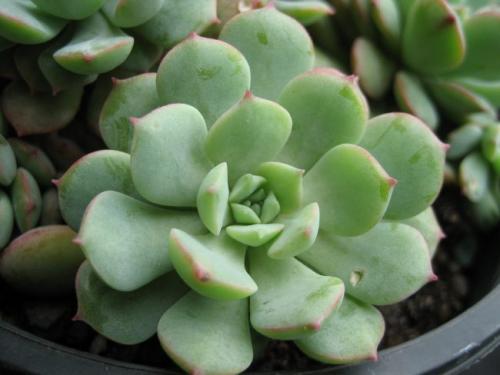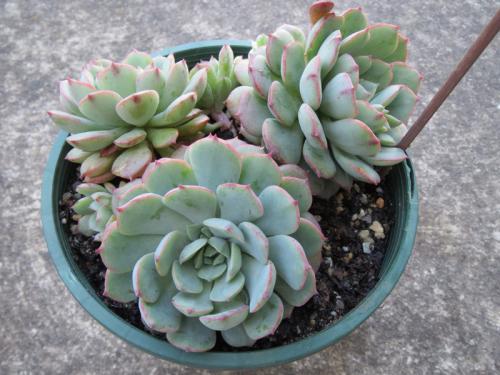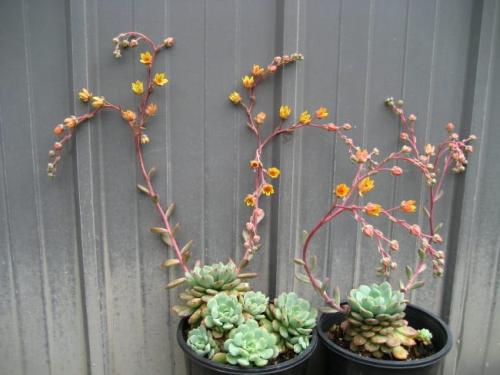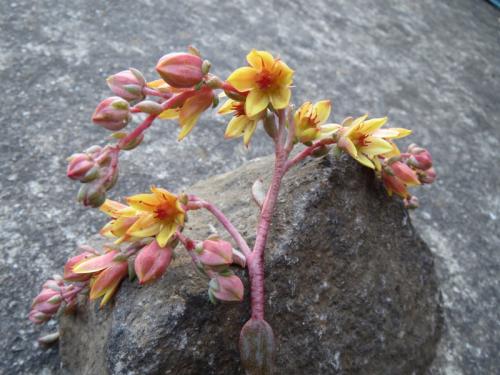Accolade (engl./ fr.) ‘아콜레이드’
Created by / Créée par Max Holmes, Australia.
First published / Publiée : Cact. Succ. J. (Woollahra) 20(4): 68-70, ills., 1996.
Parentage / Parenté : Echeveria « globulosa » = ‘Vincent Catto’ x Graptopetalum superbum.
Note :
As E. globulosa is not in cultivation since very long time, the Echeveria parent most likely is the E. hybrid ‘Vincent Catto’ – widely distributed as E. globulosa. At least the photo of the description shows this hybrid.
Comme E. globulosa n’est pas en culture depuis longtemps, c’est très probablement E. ‘Vincent Catto’ qui est le parent de cet hybride – la plante distribuée comme E. globulosa en générale est E. ‘Vincent Catto’. Au moins, la photo qui accompagne la description montre cet hybride.
X GRAPTOVERIA `ACCOLADE' - A NEW HYBRID
By Max Holmes
Cact. Succ. J. (Woollahra) 20(4): 68-70, 1996.
Published on the ICN site with permission by the author.
In spring and early summer of 1990 I decided to try my hand at producing Echeveria and X Graptoveria hybrids - a change from my experiments with Crassula hybrids. I was a little wary of branching out in this direction, as so many Echeveria hybrids have already been produced, most of them unpublished and with no detail of parentage. However, l am an incorrigible dabbler, so I went ahead.
One of the plants I chose for my crosses was Graptopetalum pentandrum subsp. superbum, a plant found at a private home in Jalisco, Mexico and named in 1987. It is a very colourful easily grown plant with heavily glaucous, purple leaves, and I thought it might lead to some attractive hybrids. This plant was distributed by the ISI in 1986 (Number 1661), correctly named, but for several years has been seen in Australian collections as "Pachyveria species, Mexico". It is of course a contradiction in terms to refer to a "Pachyveria species”, and the plant was named as a Graptopetalum by Myron Kimnach in the Cactus & Succulent Journal (US) in 1987, with clear drawings of its very typical Graptopetalum flowers. This has not stopped incorrect names though, and I notice that as recently as 1994 a large American nursery was offering it as Pachyphytum pentandrum "Superbum". No wonder the average collector is confused!
One reason why I used this Graptopetalum is because it is a fairly recent introduction, which hopefully means that it has not been much used in hybridising yet, so I would not be in much danger of copying someone else's efforts. For the pollen parent I chose Echeveria globulosa [Note], a dainty little plant which hopefully would give character to its hybrid offspring.
In March 1991 I sowed the seed and subsequently kept 3 clones for study. The most robust one showed promise, but as it grew it developed a problem which I have noticed in a few other X Graptoveria hybrids which have a Graptopetalum with purplish leaves as a parent – blotchy leaf colouring - so I decided to discard it. Over the next year or so the other 2 seedlings caught up in size and I have finally chosen one of them to name and propagate. I have chosen to name it X Graptoveria 'Accolade'. The photo shows that it is neatly intermediate between its parents in appearance.
This plant looks best when grown in strong light. It forms rosettes about 8 cm diameter of well over 40 leaves (the Graptopetalum parent has up to 20 leaves) and produces offsets readily on stems 5 mm thick and about 30 mm long. The leaves are a little less than 50 mm long, paddle shaped, slightly upturned and tipped with a mucro. They are thickly covered with a bloom making them glaucous blue-green with a more or less distinct dark pink line along the tips and extending as a short stripe a few millimetres long from the mucro along the underside of the leaf. The hybrid tends to remain almost stemless for quite some time and grows into a clump, giving it a nice, compact appearance.
Flowers appear throughout spring, starting a little earlier than either parent, being freely produced in October and November. Usually the Graptopetalum flowers in late spring and is just about finished by the time the Echeveria starts in summer, but the year I did my pollinating I was lucky enough to get the two flowering together.
The inflorescence is intermediate between the parents, having several branches and many more flowers than the Echeveria parent, but being much less spreading than that of the Graptopetalum parent . The peduncle bears quite fleshy bracts about 12 mm long, a feature apparently inherited from the Echeveria. Flowers are pink outside and yellowish inside, with a few tiny reddish spots at the petal tips and a similarly coloured indistinct stripe in the centre of the petals. The petals open substantially more than those of the Echeveria parent, but do not reflex like those of the Graptopetalum, although the stamens do reflex between the petals. They are what I would call typical X Graptoveria flowers. It is common for a mature rosette to produce at least 3 flower stems.
X Graptoveria 'Accolade' is easy to keep as a compact rosette, and gets its best colour in the cooler months. It is also easy to propagate from leaves, bracts or rosettes taken from the parent plant in winter or spring.
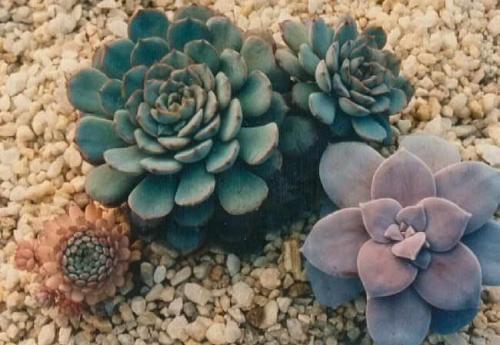
xGraptoveria `Accolade' with its parents, Echeveria globulosa (left) [see note above] and Graptopetalum pentandrum subsp. superbum (right).
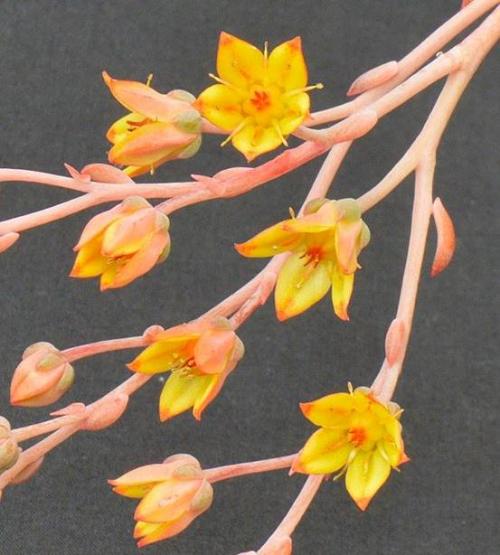
Photos Max Holmes
